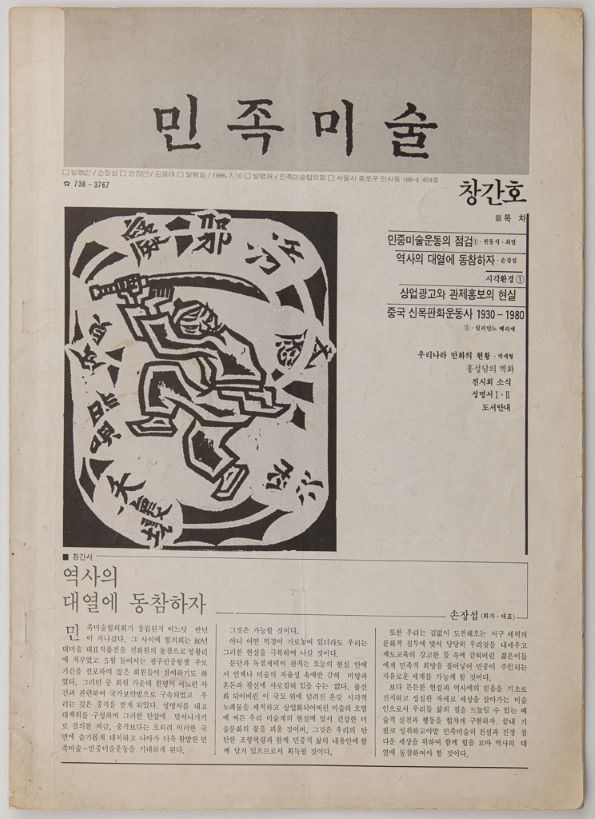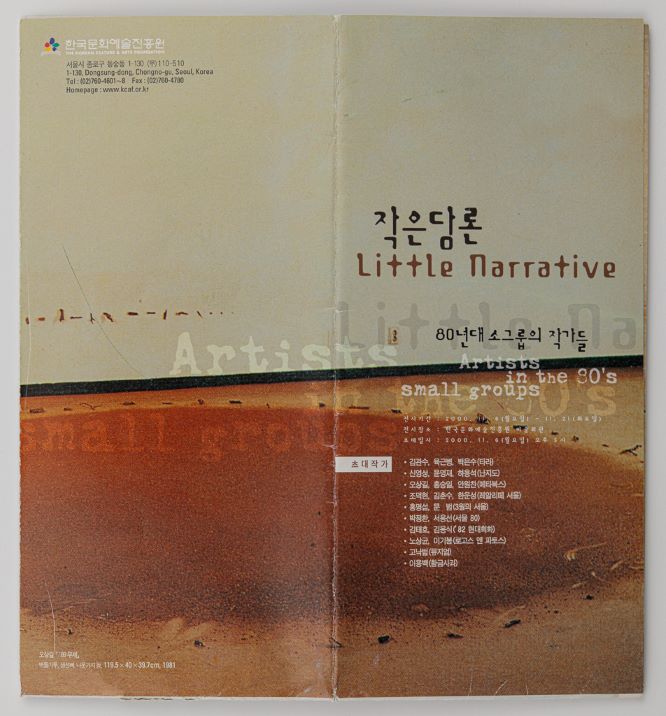
Eulchuknyeon Group Art Festival, Brochure, 1995, MMCA Art Research Center Collection, Gift of Choi Youl
Seoul Art Coalition
* Source: MMCA
Related
-

Minjung Art
An artistic movement that came to prominence alongside Korea’s democratization movement in the 1980s. Minjung artists often sought to critically portray the violent repression and corruption of the military dictatorship, to represent the experiences of laborers and farmers, and to achieve social change through art. In contrast to abstraction, which constituted the mainstream of 1970s art in Korea, Minjung Art is notable for the use of representational and figurative forms. One possible point of origin for Minjung Art is Oh Yoon’s work in the Reality Group (Hyeonsil dongin). The group was formed in 1969 by Kim Ji-ha, Oh Yoon, and Lim Se-taek. A variety of Minjung art groups were established, including the Reality and Utterance (Hyunsilgwa bareon) in 1979 by Kim Jungheun, Oh Yoon, Joo Jae-hwan, art critic Sung Wan-kyung, and Choi Min, the Gwangju Freedom Artist Association (Gwangju jayu misulin hyeopuihoe) in 1979 by Hong Sungdam and Choi Youl, the Imsulnyeon (The Year Imsul) in 1982, and the Dureong in 1983. These groups all commonly critiqued Western capitalism. In terms of form, Minjung artists adopted traditional and ethnic folk modes of expression using diverse media such as collage, printmaking, oil painting, and photography. Following the 15 Years of Korean Minjoong Arts: 1980-1994 Exhibition at the National Museum of Modern and Contemporary Art, Minjung Art became an accepted part of Korean art history. Overseas, Minjung Art has also become a recognized term that describes this genre and its unique focus on the political and social history of Korea.
-

National Art Association
An art association established in November 1985 by a collective of grassroots artists, and often also referred to as Minmihyeop. The association sought to organize artists and groups who represented the different movements within Minjung Art and to represent their varied ideas and interests. In 1995, the original association was reformed into the National Korean People’s Artists Association [Jeonguk minjok misurin yeonhap]. In turn, this was the predecessor of the Korean People’s Artists Association [Minjok misurin hyeophoe], a corporation founded in 2000.
-

Small group movement
A term describing the tendency of many artists in the 1980s to work in small groups, in which the application of many diverse methods, attitudes and values in mediums such as painting, sculpture and installation was common. These groups associated with neither the established modernist abstract art community or the Minjung Art community, which formed the primary two ideologically and formally opposed movements of the 1980s. Instead, artists within these small groups focused on individual approaches to production based on situational contingency, and deliberately declined to develop into larger organizations, unlike the artists of previous generations. The formalization, commercialization, and globalization of the art community ultimately resulted in the disbanding of most of the small groups during the 1990s. However, the works produced within these groups were indicative of the Korean post-modernist movement that was to come.
Find More
-

Silcheon Group
An alumni group of Hongik University, which was formed in 1983 by Park Hyeongsik, Son Kihwan, Lee Gyumin, Lee Myeongjun, Lee Sangho, Lee Seop, Lee Jaeyeong, and Cho Jongsik. The group held its inaugural exhibition at Kwanhoon Gallery. The group advocated “art in society,” published The Harmony of Art and Poetry—an album of poetry and paintings—and held a themed exhibition title Mass Media and Reality. In the context of the heightened political tensions during the 1980s, the group focused on the denouncement of reality and the use of visual shock for the purposes of ridiculing, mocking, scorning, and satirizing reality, rather than in the pursuit of aesthetic value.
-

Sidaejeongsin (Zeitgeist)
Sidaejeongsin (Zeitgeist) is the first collective group formed in 1983 and remained active until 1987. In the early spring of 1983, Kim Hyeonsu, the director of the Third Museum of Art, asked Park Geon to curate an exhibition to make used of the cancelled exhibition period. Together with Moon Youngtae, Park Geon formed the Committee of Sidaejeongsin and tried a collective that gathered for exhibitions and publications and then dispersed. Moon oversaw organizing exhibitions, and Park assumed the task of publications. Moon and Park first met in April 1980 when Moon visited Park’s exhibition Strength in Busan. The two became close when Park came to Seoul and participated in exhibitions Young Minds and Traverse. Their goal was to weave together the sporadic small art movements of the early 1980s with a larger “cultural force.” Their intentions can be found in the following sentence printed in small letters on the cover of the mook (magazine-book) Sidaejeongsin: “’life’ to run toward from all directions; touch, pinch and embrace.” Park Geon stated that the spirit of an artist who sees through the times is "Zeitgeist.” In the preface of the first volume of Sidaejeongsin (Zeitgeist), the art critic Kim Yoon-Soo explained that “sidaejeongsin (zeitgeist) comes from the insight and recognition that the spirit making up our lives today is indeed in a state of corruption and irreversibility” and that “zeitgeist is the awakened spirit leading national history against all the phenomena, mindsets, institutions, and systems, all of which prevent all human beings from living a dignified life.” The first Sidaejeongsin exhibition was held in April 1983 at the Third Museum of Art. The fourteen artists who participated in the exhibition were Kang Yobae, Ko Kyeong-hun, Kim Bojung, Kim Jinyeol, Moon Youngtae, Park Geon, Park Jae-dong, Ahn Changhong, Yun Yeogeol, Lee Nagyeong, Lee Chulsoo, Lee Taeho, Jung Bocsu, and Choi Minhwa. Park Geon, who had edited textbooks at a university, edited and published the first volume of the mook Sidae jeongsin, which also served as an exhibition catalogue, in 1984. From then on, the group name, exhibition name, and mook name were collectively referred to as “Sidaejeongsin.” By 1987, they had organized a total of five exhibitions and published three volumes of the Sidaejeongsin. The theme of the first volume was “The Vitality of the Minjung Art Movement,” that of the second volume was “The Aesthetics of Liberation: Murals, Photography, Prints, and Cartoons,” and that of the third volume was “Sexuality in Our Time.” The second edition of the Sidaejeongsin exhibition traveled to Maek Gallery (Busan), Ijo Gallery (Masan), and Maekhyang Gallery (Daegu). The third edition was a print exhibition organized in collaboration with the Art School for Citizens. The fourth edition was held at Min Art Gallery, and the fifth edition was held on the theme of “what do our children draw” at the same place. In 1985, the National Art Association (Minjok misul hyeopuihoe) was established. As it published its bulletin in 1986 and Min Art Gallery, an exhibition space specializing in Minjung art was established, the Committee of Sidaejeongsin concluded its activities with the fifth exhibition. Afterwards, Moon Youngtae devoted himself to the activities of the National Art Association, and Park Geon engaged himself in the activities of the National Teachers’ Council for Democratic Education Promotion [Minju gyoyuk chujin jeonguk gyosa hyeopuihoe].
-

Hoengdan
Hoengdan was the name of an art group which was active only briefly from 1980 to 1983, and it was also the theme of their exhibition. Its establishment started from a reflection on Korean contemporary art in the 1970s, by artists who believed that art cannot turn a blind eye to social reality. The principal active members of Hoengdan included Kim Jinyeol, Kim Bo-jung, Jung Bocsu, Ko Kyeong-hun, Ahn Gyeonghui, Song Simi, Lee Gapyeol, and Park Geon. Hoengdan held their first exhibition from August 28 through September 3, 1980 in the Room B of the Exhibition Hall 1 at the Misulhoegwan (now ARKO Art Center). The exhibition themed around “two-dimensional works for three walls” was curated and participated by three artists, Kim Jinyeol, Chang Sukwon, and Ham Yeon-sik. It featured twenty experimental works. Their second exhibition was held from May 29 through June 3, 1981 at Kwanhoon Gallery. Kim Bo-jung, Kim Jinyeol, Song Simi, Chang Sukwon, and Ham Yeon-sik participated in it. The works displayed in the first and second exhibitions were rather abstract and experimental. However, from 1982 onward, concrete forms began to appear in their works. As a case in point, through his People series, Kim Jinyeol depicted the daily lives of ordinary people and the social oppression they experienced. Other artists also revealed unfortunate premonitions inherent in everyday lives and projected the bleak social conditions of the early 1980s onto their works. In 1982, Hoengdan participated in the exhibition The Innocence of Conscience: That Sound, which was organized by the DAMU Group and held at Kwanhoon Gallery, along with small art groups Jeongae, DAMU Group, and TARA. In 1983, it organized the exhibition Noise, Confusion, and Disturbance held from May 4 to 10 at Kwanhoon Gallery. Its third exhibition was held from November 24 to 30, 1983. Afterward, the group’s activities were discontinued. The discontinuation is not unrelated to the quick migration of the major players among figurative artists to the Hangang Museum when Jang Gyeongho, who led the organization of the exhibition Young Minds, moved to a curatorial position at the Hangang Museum, which opened in June 1984. Another reason for the group’s dissolution is disagreements among the founding members of Hoengdan regarding the visual representations of oppression in Korean society at the time. Kim Jinyeol was the only Hoengdan founding member who participated in the opening exhibition, The Grandiose Root, of the Hangang Museum. After a five-year hiatus, an exhibition of Hoengdan was held in April 1989 at Gallery Doll. The participating artists were Jeong Jeongsik, Ko Kyeong-hun, Yu Seongsuk, Park Jeongae, Kim Sanha, Jung Bocsu, Baek Dongmin, Ahn Gyeonghui, and Roh Jaesoon. Hoengdan tried to start anew, but there was no further activity after this exhibition.






